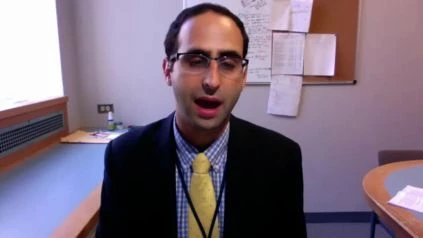Ari Rosenberg, MD at The University of Chicago discusses an abstract from ASCO 2020 entitled Dose and volume de-escalation for HPV-associated oropharyngeal cancer: Long-term follow-up of the OPTIMA trial
Bottom line:
Human papilloma virus (HPV) related oropharyngeal cancer has a good prognosis, but conventional multimodality treatment is associated with significant toxicity associated with treatment. A model for treatment de-escalation that optimizes oncological results while reducing toxicity is needed. We tried to further expound our reported OPTIMA results with long-term follow-up and subsequently treated additional pts using the OPTIMA treatment paradigm.
Approaches:
There was a long-term follow-up of our institutional OPTIMA de-escalation research (NCT02258659) and a retrospective analysis of additional patients subsequently treated according to the OPTIMA outline. Pts were graded as low-risk (LR) (almost T3, although N2B, although 10PYH) or high-risk (HR) (T4, al. N2c, > 10PYH). Pts was treated with 3 cycles of dose-dense carboplatin and nab-paclitaxel (OPTIMA) or paclitaxel (subsequently treated) induction chemotherapy (IC). LR received low-dose radiotherapy (LD) to 50 Gy with an average 50 percent response. Intermediate-dose chemoradiotherapy (CRT) to 45Gy was obtained by LR with a 30-50 percent response or HR with a 50 percent response. All the others got full-dose CRT to 75Gy.
Reviews:
From October 2014 to November 2019, 108 pts consented and 107 treated (61 on study; 46 subsequently). Post-enrollment 1 pt of transferred treatment. The median follow-up period was 36 months (17-45 interquartile range). The median age was 63 years ( range 33-84) and male was 95 per cent. 47% were LR and 53% were HR. About 50% were de-escalated (C)RT in 78/107 (73%) of pts and 37/51 (73%) in LR; 41/56 (73%) in HR. 82% of pts were de-escalated (C)RT. Overall, at the last follow-up 94 per cent of pts were alive (98 per cent LR; 89 per cent HR). 3 pts (2 HR and 1 LR) developed a recurrence of the disease (2.7 percent), with 2 local recurrences and 1 remote recurrence. The likelihood of G-tube placement was 3% for low-dose RT, 35% for intermediate-dose CRT, and 84% for full-dose CRT.
Findings:
With long-term follow-up, IC supplemented by risk-adapted dose and volume de-escalated care for HPV+ oropharyngeal cancer shows excellent oncologic and functional outcomes. Funded by Celgene, Grant Achatz / Nick Kokonas and National Cancer Institute of National Institutes of Health ( NIH) sponsored Alinea through Grant Number P30 CA14599. Data about clinical trials: NCT02258659.

